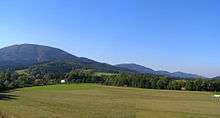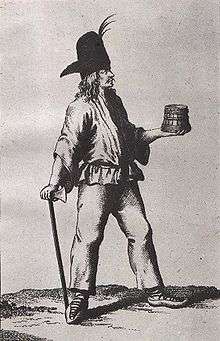Moravian Wallachia
Moravian Wallachia (Czech: Moravské Valašsko, or simply Valašsko; Romanian: Valahia Moravă), is a mountainous ethnoregion located in the easternmost part of Moravia in the Czech Republic, near the Slovak border, roughly centered on the cities Vsetín, Valašské Meziříčí and Rožnov pod Radhoštěm.[1] The name Wallachia used to be applied to all the highlands of Moravia and the neighboring Silesia, although in the 19th century a smaller area came to be defined as ethno-cultural Moravian Wallachia. The traditional dialect (rarely heard these days) represents a mixture of elements from the Czech and Slovak languages, and has a distinct lexicon of Romanian origin relating to the pastoral economy of the highlands. The name originated in the "Vlachs", an originally Romance-speaking community that migrated to Moravia.
Geography and anthropology

Moravian Wallachia is a mountainous region located in the easternmost part of Moravia in the Czech Republic, near the Slovak border, roughly centered on the cities Vsetín, Valašské Meziříčí and Rožnov pod Radhoštěm. It is part of the Western Carpathians.
It is bordered to the west with Lachia (Czech: Lašsko) along the Štramberk–Příbor–Frýdek line (according to Šembera) or according to dialectology (according to František Bartoš).[2]
Culture
The population is traditionally pastoralist. Although animal husbandry was long associated with agriculture practiced in the lowlands adjacent to the Western Carpathians, the Vlach methods and associated rituals of sheep and goat tending were unique and newly introduced by them, as were the introduction of grazing in the highlands and the emphasis upon the production of milk and cheese (bryndza). The "Vlach" dress are still important elements of the ethnography of the Czech Republic, Slovakia and Poland. The music of the area is thought to have been influenced by the Vlachs (e.g. see Lachian Dances), but it also represents a locally vibrant mixture of Vlachian with Slovak, Czech, German, and Polish music cultures from the Tatras and Morava valley.[3]
History
Origin
It is unclear exactly why and when the Vlach migrations into what is today Czech Republic and Slovakia occurred.[4] According to Lozovan, the Vlachs were at first Romance-speaking and Orthodox Christian, transhumant pastoralists originating in Transylvania.[5] Kamusella notes that Vlachs migrated up along the Carpathians to Moravia between the 13th and 18th centuries and that most preserved Orthodox Christianity but were Slavicized.[6]
Early modern period

The Vlachs in eastern Moravia rose up during the Thirty Years' War (1618–48). They fought successfully against Habsburg rule in 1620–23, and were initially supported by rebellious Protestant Hungarians. Having had all of Moravia east of the Morava river under their control by 1621, the Vlachs were defeated in 1623, after which a series of public executions took place. They renewed attacks in late 1623, and notably defeated a Polish contingent in March 1624. In 1625–30 Habsurg and Danish armies repeatedly crossed Moravia. The Vlachs joined the Danes, and later, the Swedes. After the Danish retreat in 1627, and Swedish retreat in 1643, the Habsburgs finally defeated the Vlachs in 1644.[7]
Modern period
From at least the mid-18th century the populace of Moravian Wallachia described itself as Wallachian. At that time, in German, the community was known as die Wallachey. Daniel Sloboda replaced the term Ualachy (Vlahi) with Ualassko (Valasko), and defined the Moravian Wallach as a shepherd, and stressed that the term had nothing to do with Romanians. He noted that the speech was of elements of Polish and East Slavic dialects.[8]
In 1866, Hyde Clarke reported that the Moravians viewed the Moravian Vlachs (Wallachians) as an "alien race", but Slavic-speaking. They had characteristic habits and dress.[9]
Notable people
- Leoš Janáček - famous music composer
- Milan Baroš - football player
- Jan Antonín Baťa - businessman, shoemaker (Bata Shoes)
- Tomáš Baťa - shoemaker
- Tomáš Berdych - professional tennis player
- Radoslav Brzobohatý - Czech actor
- Ota Filip - novelist, journalist, published in Czech and German
- Bohuslav Fuchs - pioneer of modern architecture
- Alois Hába - composer
- Markéta Irglová - singer-songwriter, Academy Award winner
- Boleslav Polívka - actor
- Tom Stoppard - British author and playwright
- Ivana Trump - American business woman, ex-wife of Donald Trump
- Mirek Topolánek - former Czech Prime Minister
- Ludvík Vaculík - Czech writer and co-author of Charter 77 (with Jan Patočka and Václav Havel)
- Emil Zátopek - long-distance runner best known for winning three gold medals at the 1952 Summer Olympics in Helsinki
See also
References
- The Wallachian Village-a short history on Wallachian region. In open-air museum Rožnov Pod Radhoštěm 2012 Archived 2017-10-27 at the Wayback Machine
- Kevin Hannan (1996). Borders of Language and Identity in Teschen Silesia. Peter Lang. p. 67–71. ISBN 978-0-8204-3365-3.
- Johnston 2010.
- Czechoslovak Society of Arts and Sciences in America (1968). Czechoslovakia Past and Present: Political, international, social, and economic aspects. Mouton. p. 686.
- Lozovan 2015, p. 175.
- Kamusella 2008, p. 64.
- Polišenský 1971.
- Kevin Hannan (1994). Language and Identity in a West Slavic Borderland: The Case of Teschen Silesia. University of Texas at Austin. pp. 124–125, 148.
- The Anthropological Review. Trübner and Company. 1866. pp. 91–.
Further reading
- Kamusella, T. (2008). The Politics of Language and Nationalism in Modern Central Europe. Springer. ISBN 978-0-230-58347-4.CS1 maint: ref=harv (link)
- Konecny, Z.; Mainus, F. (1979). Stopami Minulosti: Kapitol z Dejin Moravy a Slezka [Traces of the Past: Chapters from the History of Moravia and Silezia]. Brno: Blok.
- Lozovan, Eugen (2015). Dacia sacra. Bucuresti: Editura Saeculum. ISBN 978-973-9399-17-3.CS1 maint: ref=harv (link)
- Polišenský, Josef V. (1971). The Thirty Years War. University of California Press. ISBN 978-0-520-01868-6.CS1 maint: ref=harv (link)
- Jaroslav Štika (1973). Etnografický region Moravské Valašsko: jeho vznik a vývoj. Profil.
- Bartoš, František (1880), "Moravské Valašsko kraj i lid" (PDF), Osveta
- Matouš Václavek (1894). Moravské Valašsko: Lidopisné obrazy příspěvkem ke kulturním dějinám českým.
- Eckert, Eva. (1993). Varieties of Czech: Studies in Czech Sociolinguistic. Atlanta/Amsterodam, Rodopi. p. 53-54
- Short, D. (1993). Czech Republic and Slovak Republic: language situation. In: Asher R.E. (ed.) The Encyclopedia of Language and Linguistic, Oxford, vol. 2, 804-805
- A Group of co-authors (2007): Přírodou a historií Valašskomeziříčska po naučných stezkách (Around the Nature and History of Valašské Meziřičí county), Valašské Meziříčí, Český svaz ochránců přírody. 66 Pages. ISBN 978-80-254-4470-2.(in Czech)
- Johnston, Jesse A. (2010). "The Cimbál (Cimbalom) and Folk Music in Moravian Slovakia and Vallachia". Journal of the American Musical Instrument Society. 36: 78–117. hdl:2027.42/87955.
External links
- https://web.archive.org/web/20100503172548/http://www.vsacan.cz/en/ Vsacan, a Wallachian song and dance ensemble.